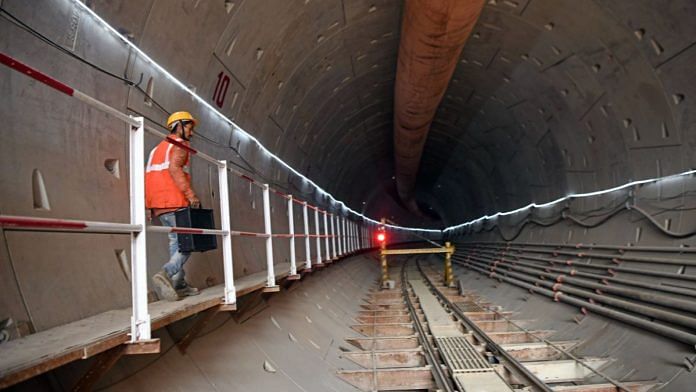New Delhi: Nearly seven years after the Delhi government, following Supreme Court’s direction, began levying an ‘environmental compensation charge’ (ECC) on all commercial vehicles entering the National Capital Territory (NCT) to address the problem of air pollution, a significant portion of the collected funds has remained untouched.
Of the Rs 1,464 crore collected, the Delhi government has allocated Rs 781.51 crore for seven projects, resulting in nearly 50 percent of the funds remaining unutilised, ThePrint has learnt.
The government’s most recent utilisation of the fund was in May this year, when it gave Rs 500 crore to the National Capital Region Transport Corporation (NCRTC) as the second installment of its contribution towards the Delhi-Meerut Regional Rapid Transit System (RRTS).
Currently, the ECC fund has a balance of Rs 682.49 crore, according to the copy of a government report accessed by ThePrint.
The ECC, imposed by the Supreme Court, is collected by the Municipal Corporation of Delhi (MCD) and is deposited with the government’s transport department. The charge is levied on light and heavy-duty goods vehicles entering Delhi, excluding CNG vehicles, passenger vehicles, ambulances and trucks carrying essential commodities.
According to the report, a majority of the expenditure — Rs 765 crore of Rs 781.51 crore — from the fund has gone towards paying the NCRTC.
The first instalment of Rs 265 crore for the RRTS was paid out of the ECC fund in 2019. A majority of the payments made by the government through the fund were a result of Supreme Court orders.
The government’s total share of costs for the RRTS project — which consists of semi-high speed rail corridors connecting Delhi to Meerut — stands at Rs 1,180 crore.
A senior Delhi government official told ThePrint that the government is planning to approach the SC to utilise the fund for electric buses and its charging stations. “We are looking to use the fund for environment-friendly and pollution combating solutions in the transport sector,” the official added.
According to the report, the government paid Rs 9 crore to the Indian Oil Corporation in 2020 as part of the second instalment of the Hydrogen-CNG (HCNG) project that involved the setting up of HCNG plant and dispensing station in the city. The first instalment of Rs 6 crore for the project was also paid out of the ECC fund in 2019.
Another Delhi government official, however, explained that the said project has been scrapped, adding that its results were not viable and that the same reflected in a trial where 50 HCNG cluster buses were put to test.
From 2016 to 2019, a total Rs. 1.51 crore was utilised by the government to pay the MCD for a Radio Frequency Identification (RFID) project, followed by the Public Works Department (PWD) and the District Magistrate (Central) for the improvement of non-motorised vehicle lanes and deployment of civil defence volunteers as traffic marshals.
Also read: Why make buses electric when no one uses them? Delhi’s EV roadmap is hotly contested
How to utilise ECC fund
According to the Delhi Pollution Control Committee’s (DPCC) policy on utilisation of ECC funds, it can be used for the developing infrastructure for air and water quality surveillance, along with procuring equipment and hiring experts for remediation of contaminated sites.
Further, the fund can be used for specific investigations and studies that are related to environment and ecology and to carry capacity assessment for ecologically and environmentally sensitive areas.
Another senior Delhi government official told ThePrint that funds were never utilised for the procuring equipment, such as anti-smog guns and water sprinklers, to combat air pollution, adding that there were sufficient funds for capital expenditure.
He added that a majority of the work for intervention for air quality is divided among various departments — including the PWD, MCD and the transport department — while the environment department plays an advisory role by providing action plans.
When asked whether the fund has been utilised for any of the activities under the Delhi Pollution Control Committee, the second senior official quoted earlier said, “No, it is yet to be done”.
Last week, Delhi Environment Minister Gopal Rai told reporters that the winter action plan will be announced on 1 October by Chief Minister Arvind Kejriwal, adding that 13 hotspots have been identified in the city and that a team has been formed for each hotspot.
ThePrint reached Rai via WhatsApp messages for a comment over the utilisation of the ECC fund. This story will be updated if and when a response is received.
The winter period in Delhi has been witnessing a regular spike in air pollution levels in the past years.
Rai also said that the government is working on 15 points, which include focus on vehicular pollution, burning of garbage in the open, ban on firecrackers, tree plantation and implementing the GRAP (Graded Response Action Plan), among others.
Earlier this month, the government announced a complete ban on the storage, sale and bursting of firecrackers.
(Edited by Zinnia Ray Chaudhuri)
Also Read: Escaping the Chinese connection in EV space impossible. This Indian company can change that






